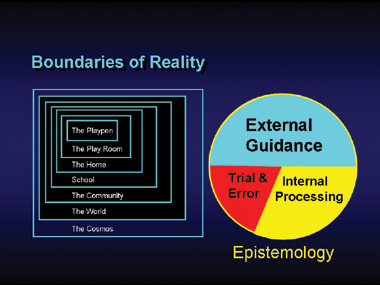This is the classic question that Pilate posed rhetorically ...and rather cynically. And the very existence of truth is continuing to be trampled by pompous professors, prostituted politicians, and arrogant attorneys. Now with the blockbuster movie, The Da Vinci Code, promoting blasphemous heresies about the embodiment of Truth itself, we can’t escape this skillfully coordinated attack against those who take truth seriously. Yet, the pursuit of truth is our most critical of endeavors and upon which our eternal destiny rests.
Epistemology is the study of knowledge, its scope and limits. And yet this most basic of studies is rarely dealt with today. How do we really ''know''? How do we determine what is really true, rather than that which is just traditionally accepted? What are our tools for validation?
 As we began in the very limited universe of our playpen, our primary reliance on learning techniques was empirical: trial and error. As our universe gradually expanded to include our room, our home, our school, and our community, our primary epistemological tools increasingly relied on external guidance, qualified and validated by means of our internal processing. (See chart, right.) As our universe of interest expands from our community to the world, and ultimately to the cosmos itself, our tools increasingly rely on external guidance rather than trial and error! Qualifying our sources of information becomes increasingly critical. Yet, what tools can we use to qualify our sources of information?
As we began in the very limited universe of our playpen, our primary reliance on learning techniques was empirical: trial and error. As our universe gradually expanded to include our room, our home, our school, and our community, our primary epistemological tools increasingly relied on external guidance, qualified and validated by means of our internal processing. (See chart, right.) As our universe of interest expands from our community to the world, and ultimately to the cosmos itself, our tools increasingly rely on external guidance rather than trial and error! Qualifying our sources of information becomes increasingly critical. Yet, what tools can we use to qualify our sources of information?
The Boundaries of Our Reality
In inventorying our available epistemological tools, we must first understand the boundaries of our reality. One of the startling discoveries of 20th century science is that our universe is finite. It has limits in regards to both the macrocosm - there is a limit to ''largeness'' - and the microcosm - there is a limit to ''smallness''! It is astonishing to realize that we actually live within a digital simulation of reality. In the macrocosm, we now know that the universe is finite, having begun at a ''singularity,'' and will ultimately suffer a thermodynamic ''heat death'' when it finally exhausts the available energy.
What is perhaps the most surprising is the discovery that, in the microcosm, everything - length, mass, even time itself - is made up of indivisible units - called ''quanta.'' When subatomic particles are ''divided'' they lose ''locality.'' The property of ''non locality'' is one of the deepest mysteries of quantum physics, and it shatters all of our previous notions of ''reality.'' A recent issue of Scientific American suggested that what we perceive as physical reality now appears to be a mere shadow of a larger reality.1
To begin to understand our boundaries, we would need to probe the perceptions of both the macrocosm and the microcosm and apply the tools of hypothesis testing to validate our assumptions. This, too, might prove an exercise in futility were it not for a distinct, and self-validating, message from outside those very boundaries!
While most of us think of our space as three-dimensional, we now know, thanks to Dr. Einstein, that we actually live in four: time itself is a physical property of our ''space.'' (The Apostle Paul also indicated this four-dimensional reality in his letter to the Ephesians.2)
Scientists currently believe we live in ten dimensions. (Something that Nachmonides, a 13th century Hebrew sage, concluded in his commentary on the Book of Genesis!) It is toward this hyperspace (a space of more than 3-dimensions) that our conceptions of the real ''reality'' must reach to have any validity. Fortunately, we have in our possession a verifiable message of hyper-dimensional origin that will be the subject of the next article in this series.
Notes:
- ''The Inconstancy of Constants,'' Scientific American, June 2005, p. 57-63.
- Ephesians 3:18.






